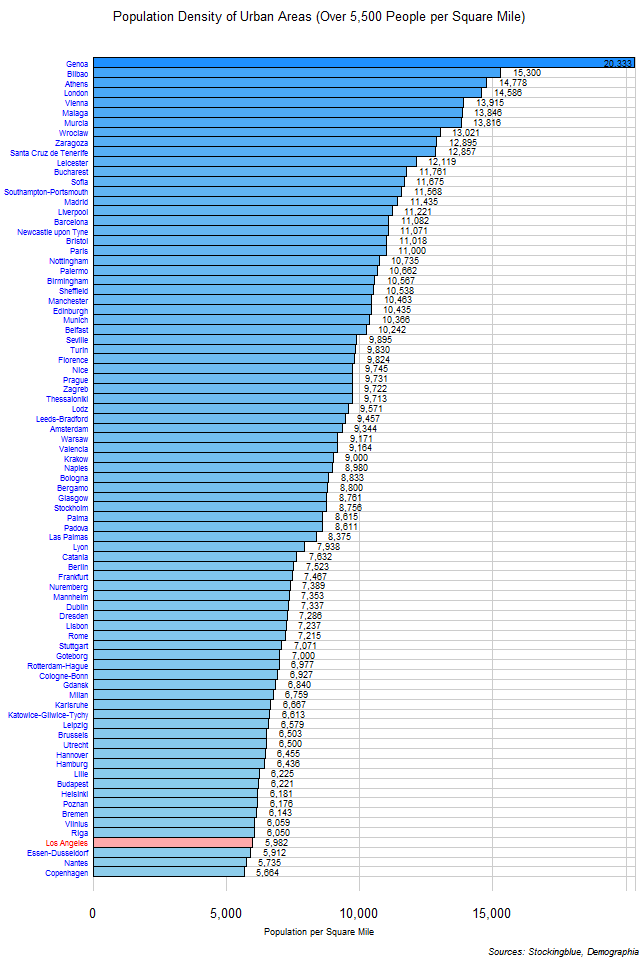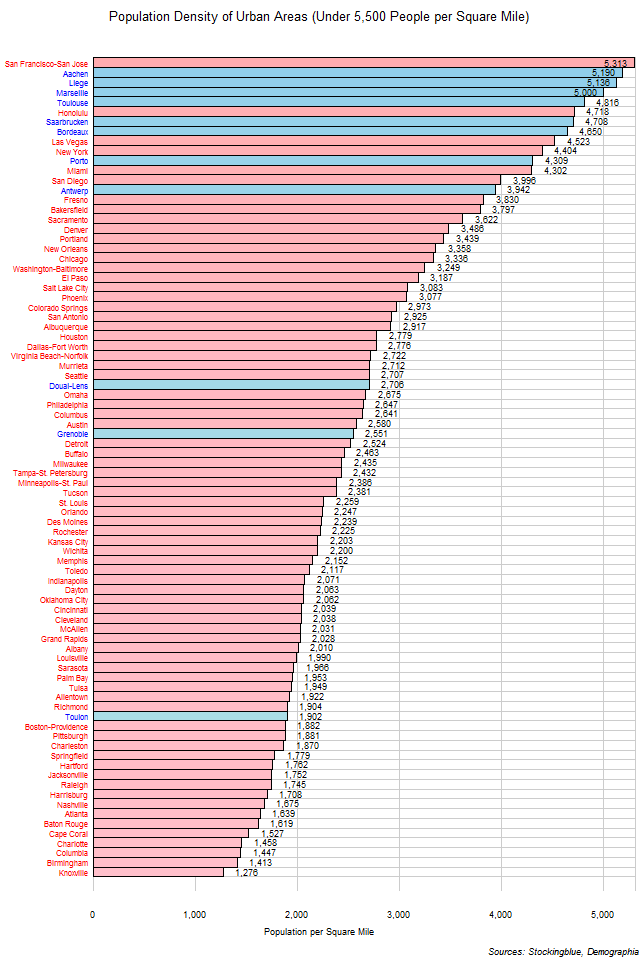
The chart above shows the population density of each urban area with a population of over 500,000 with a population density over 5,500 people per square mile (2,124 people per square kilometer) while the chart below shows all urban areas with a population of over 500,000 with a population density under 5,500 people per square mile. The urban areas have been normalized so as to avoid any inconsistencies with how cities and their metropolitan areas are defined by their governments. Each urban area has similar characteristics making this the definitive method with which to compare cities across various countries. Most large EU cities have a population density over 5,500 people per square mile and populate the above chart while most US cities have a population density under 5,500 people per square mile and thus populate the chart below.
Findings

- The difference between the urban area with the greatest population density, Genoa, and the urban area with the least, Knoxville, is 19,057 people per square mile (7,358 people per square kilometer).
- Genoa has 15.93 times the population density that Knoxville does.
- The median population density of urban areas with a minimum population of 500,000 in the 28 EU states is 8,615 people per square mile (3,326 people per square kilometer) and the mean 8,647.13 people per square mile (3,338.68 people per square kilometer).
- The median population density of urban areas with a minimum population of 500,000 in the 50 US states is 2,253 people per square mile (870 people per square kilometer) and the mean 2,574.03 people per square mile (994 people per square kilometer).
- The median population density of urban areas with a minimum population of 500,000 in the 78 EU and US states is 5,313 people per square mile (2,051 people per square kilometer) and the mean 5,956.05 people per square mile (2,299.65 people per square kilometer).
Caveats
- Data is from 2020.
- The methodology for how these urban areas have been defined can be found in the source link below. As of this writing this is the most reliable way to compare urban areas throughout the world.
- Some of these urban areas span several states, and the state that is being used here is the one where the core of the urban area is located. For instance, New Jersey has parts of the New York City and Philadelphia urban area within it but both of those cores are located in the states of New York and Pennsylvania and are thus included in those states and not New Jersey.
- All figures are rounded to the nearest whole.
Details
Only 56 of the 78 EU and US states and Washington DC have urban areas with at least 500,000 people. Of these, only EU states have ten urban areas with a population of over 500,000. These include Germany with 16; the United Kingdom with 14; and France, Italy, and Spain with 11 each. The US states with the most urban areas with over 500,000 people are California and Florida with seven each.
All 28 of the urban areas with a population of over 500,000 people that have a population density of over 10,000 people per square mile (3,861 people per square kilometer) are located in the EU. All but one of 23 of the urban areas that have a population density less than 2,000 people per square mile (772 people per square kilometer) are located in the US.
Austria has the largest mean population density in its urban areas of over 500,000 people with a mean of 13,915 people per square mile (5,373 people per square kilometer) distributed among its one urban area. In the US, Hawaii has the largest mean population density in its urban areas of over 500,000 people with a mean of 4,718 people per square mile (1,822 people per square kilometer) distributed among its one urban area.
Cyprus, Estonia, Luxembourg, Malta, Slovakia, and Slovenia in the EU do not have any urban areas with a population of over 500,000 inhabitants. Alaska, Arkansas, Delaware, Idaho, Maine, Maryland, Mississippi, Montana, New Hampshire, New Jersey, North Carolina, North Dakota, Rhode Island, South Dakota, Vermont, West Virginia, and Wyoming in the US do not have any urban areas with a population of over 500,000 inhabitants.
Sources
Demographia. 2021. "Demographia World Urban Areas: 16th Annual Edition." Accessed March 9, 2021. http://demographia.com/db-worldua.pdf.